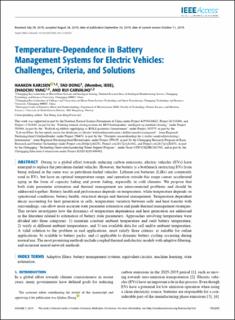| dc.contributor.author | Karlsen, Haakon | |
| dc.contributor.author | Dong, Tao | |
| dc.contributor.author | Yang, Zhaochu | |
| dc.contributor.author | Carvalho, Rui | |
| dc.date.accessioned | 2020-04-07T07:56:46Z | |
| dc.date.available | 2020-04-07T07:56:46Z | |
| dc.date.created | 2020-02-01T20:48:24Z | |
| dc.date.issued | 2019 | |
| dc.identifier.citation | Karlsen, H., Dong, T., Yang, Z., & Carvalho, R. (2019). Temperature-Dependence in Battery Management Systems for Electric Vehicles: Challenges, Criteria, and Solutions. IEEE Access, 7, 142203-142213. | en_US |
| dc.identifier.issn | 2169-3536 | |
| dc.identifier.uri | https://hdl.handle.net/11250/2650586 | |
| dc.description.abstract | Owing to a global effort towards reducing carbon emissions, electric vehicles (EVs) have emerged to replace the petroleum-fueled vehicles. However, the battery is a bottleneck restricting EVs from being utilized in the same way as petroleum-fueled vehicles. Lithium-ion batteries (LiBs) are commonly used in EVs, but have an optimal temperature range, and operation outside this range causes accelerated aging in the form of capacity fading and power fading, especially in cold climates. We propose that both state parameter estimation and thermal management are interconnected problems and should be addressed together: Battery health and performance depends on temperature, while temperature depends on operational conditions, battery health, structural design and thermal management. Temperature dependent decay accounting for heat generation in cells, temperature variation between cells and heat transfer with surroundings, can allow more accurate state parameter estimation and guide thermal management strategies. This review investigates how the dynamics of temperature dependence and heat generation are addressed in the literature related to estimation of battery state parameters. Approaches involving temperature were divided into three categories: 1) maintain constant ambient temperature and omit battery temperature, 2) verify at different ambient temperatures, and 3) use available data for cell and/or ambient temperature. A valid solution to the problem in real applications, must satisfy three criteria: a) suitable for online applications, b) scalable to battery packs, and c) applicable to dynamic battery cycling occurring during normal use. The most promising methods include coupled thermal and electric models with adaptive filtering, and recurrent neural network methods. | en_US |
| dc.language.iso | eng | en_US |
| dc.rights | Navngivelse 4.0 Internasjonal | * |
| dc.rights.uri | http://creativecommons.org/licenses/by/4.0/deed.no | * |
| dc.title | Temperature-dependence in battery management systems for electric vehicles: Challenges, criteria, and solutions | en_US |
| dc.type | Peer reviewed | en_US |
| dc.type | Journal article | en_US |
| dc.description.version | publishedVersion | en_US |
| dc.source.pagenumber | 142203-142213 | en_US |
| dc.source.volume | 7 | en_US |
| dc.source.journal | IEEE Access | en_US |
| dc.identifier.doi | 10.1109/ACCESS.2019.2943558 | |
| dc.identifier.cristin | 1789674 | |
| cristin.ispublished | true | |
| cristin.fulltext | original | |
| cristin.qualitycode | 1 | |

